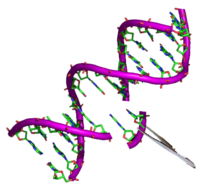
Photo from wikipedia
Significance Most if not all songbirds possess a germline-restricted chromosome (GRC) which is believed to be exclusively maternally inherited. However, we show that, in the zebra finch, the GRC can… Click to show full abstract
Significance Most if not all songbirds possess a germline-restricted chromosome (GRC) which is believed to be exclusively maternally inherited. However, we show that, in the zebra finch, the GRC can also be paternally inherited and that the potential for paternal inheritance may differ between families. We further show that the genetic diversity of the GRC is extremely reduced compared to the high diversity of mitochondrial DNA lineages, suggesting that a single GRC haplotype has spread through the Australian zebra finch population relatively recently via occasional paternal inheritance. Our study therefore suggests that the GRC has the potential to evolve in a selfish manner, which could result in intragenomic conflict. Songbirds have one special accessory chromosome, the so-called germline-restricted chromosome (GRC), which is only present in germline cells and absent from all somatic tissues. Earlier work on the zebra finch (Taeniopygia guttata castanotis) showed that the GRC is inherited only through the female line—like the mitochondria—and is eliminated from the sperm during spermatogenesis. Here, we show that the GRC has the potential to be paternally inherited. Confocal microscopy using GRC-specific fluorescent in situ hybridization probes indicated that a considerable fraction of sperm heads (1 to 19%) in zebra finch ejaculates still contained the GRC. In line with these cytogenetic data, sequencing of ejaculates revealed that individual males from two families differed strongly and consistently in the number of GRCs in their ejaculates. Examining a captive-bred male hybrid of the two zebra finch subspecies (T. g. guttata and T. g. castanotis) revealed that the mitochondria originated from a castanotis mother, whereas the GRC came from a guttata father. Moreover, analyzing GRC haplotypes across nine castanotis matrilines, estimated to have diverged for up to 250,000 y, showed surprisingly little variability among GRCs. This suggests that a single GRC haplotype has spread relatively recently across all examined matrilines. A few diagnostic GRC mutations that arose since this inferred spreading suggest that the GRC has continued to jump across matriline boundaries. Our findings raise the possibility that certain GRC haplotypes could selfishly spread through the population via occasional paternal transmission, thereby outcompeting other GRC haplotypes that were limited to strict maternal inheritance, even if this was partly detrimental to organismal fitness.
Journal Title: Proceedings of the National Academy of Sciences of the United States of America
Year Published: 2022
Link to full text (if available)
Share on Social Media: Sign Up to like & get
recommendations!